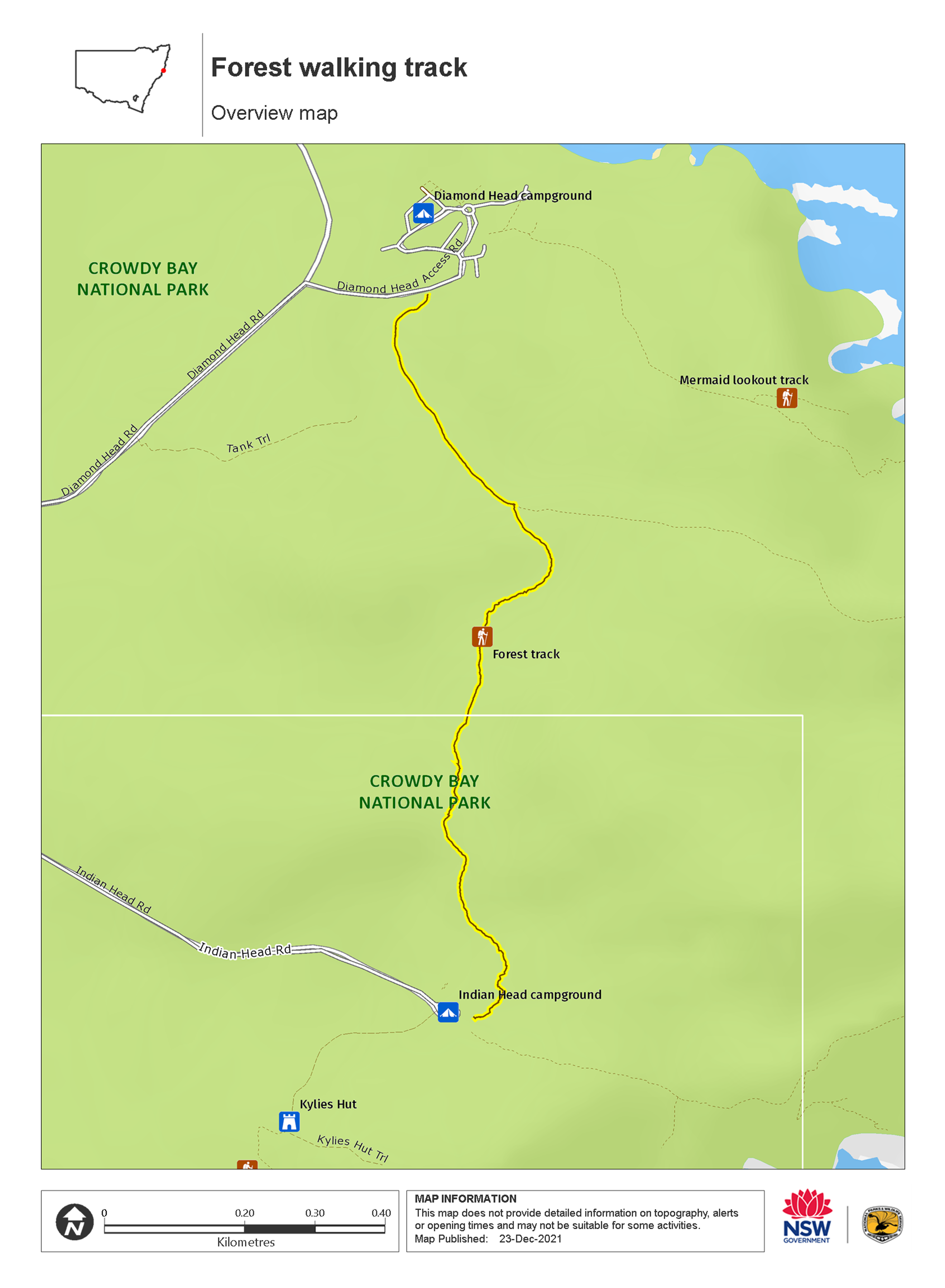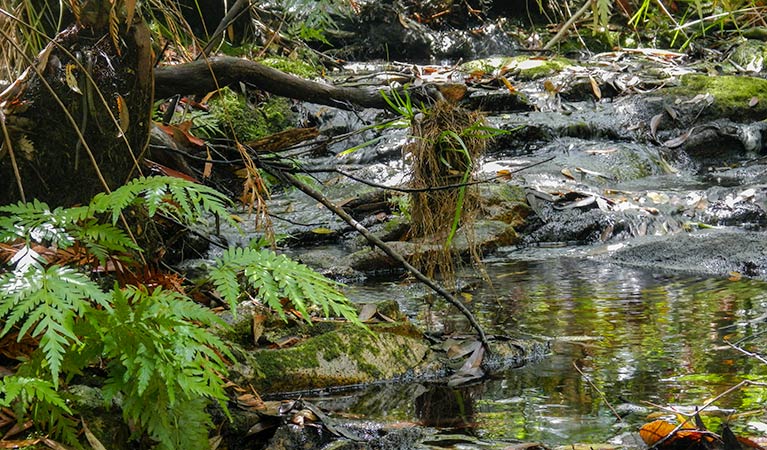Overview
Forest walking track offers a scenic stroll through lush rainforest, woodlands and native grassland in Crowdy Bay National Park.
- Where
- Crowdy Bay National Park in North Coast
- Accessibility
- Hard
- Distance
- 1.5km one-way
- Time suggested
- 45min - 1hr 15min
- Grade
- Grade 3
- Entry fees
- Park entry fees apply
- Please note
- It’s a good idea to put sunscreen on before you set out and remember to take a hat and take plenty of water
- Remember to take your binoculars if you want to birdwatch
- Toilets and picnic facilities are located at both Indian Head and Diamond Head campgrounds
Forest walking track explores the lush rainforest, woods and native grasses of Crowdy Bay National Park. This short track, on the western side of Indian Head, will delight all ages and shows why this coastal park is so special.
You’ll pass through lush rainforest with glossy ferns. Listen for the distinct call of the green catbird and you might glimpse a bower bird among the foliage. Towering turpentines give way to she-oaks and three different types of banksias.
Winding down towards the creek, the path opens up to grasslands, including delicate ground orchids and rare kangaroo grass. In summer, gorgeous Christmas bells and wildflowers pop up through the dunes.
Begin this walk from either Indian Head or Diamond Head campgrounds. Retrace your steps or join Diamond Head loop and take in the sweeping ocean views.
Take a virtual tour of Forest walking track captured with Google Street View Trekker.
Map

Map legend

Local alerts
For the latest updates on fires, closures and other alerts in this area, see https://www.nationalparks.nsw.gov.au/things-to-do/walking-tracks/forest-walking-track/local-alerts
General enquiries
- National Parks Contact Centre
- 7am to 7pm daily
- 1300 072 757 (13000 PARKS) for the cost of a local call within Australia excluding mobiles
- parks.info@environment.nsw.gov.au
Park info
- in Crowdy Bay National Park in the North Coast region
Crowdy Bay National Park is always open but may have to close at times due to poor weather or fire danger.
-
Park entry fees:
$8 per vehicle per day.
Buy annual pass.
Visitor info
All the practical information you need to know about Forest walking track.
Track grading
Features of this track
Distance
1.5km one-way
Time
45min - 1hr 15min
Quality of markings
Sign posted
Experience required
Some bushwalking experience recommended
Gradient
Short steep hills
Quality of path
Formed track, some obstacles: The walk is 1-2m wide and gravel along its length, with a short rocky, eroded section in the middle of the walk when you reach the creek.
Steps
Occasional steps: There are 4 steps at the creek crossing. They are steep and there's no handrail.
Other barriers
Other barriers: There's a steep creek crossing around the middle of the walk. The track narrows at this point.
Accessible options
The northern part of the walk starting from Diamond Head campground from to the creek crossing, or the southern part of the walk from Indian Head campground to the creek crossing may be accessible for people with reduced mobility.
Getting there and parking
Indian Head campground is in the northern section of Crowdy Bay National Park. Access is via Diamond Head Road.
Parking
Parking is available at either end of the track, in a gravel carpark at Indian Head campground or in asphalt carparks at Diamond Head campground.
Best times to visit
Crowdy Bay National Park generally enjoys a warm subtropical climate. However outside of winter the temperature can reach above 30C, so be sure to carry sunscreen, a hat and plenty of water. Drinking water is not available within the park. Winter days and nights can be cool to cold, particularly in exposed areas of the park.
Spring
Wildflowers paint the dunes and heath in spectacular colour during spring.
Summer
Swimming, boating and fishing – enjoy the delights of Crowdy Bay's magnificent beaches Look out for the festive Christmas Bell blooms.
Winter
Remember your binoculars and camera to experience the sight of migrating whales.
Weather, temperature and rainfall
Summer temperature
Average
19°C and 25°C
Highest recorded
43.3°C
Winter temperature
Average
10°C and 19°C
Lowest recorded
-1.7°C
Rainfall
Wettest month
February and March
Driest month
September
The area’s highest recorded rainfall in one day
310mm
Facilities
There are flush toilets at Diamond Head campground where this walk begins and non-flush toilets and cold showers at Indian Head campground where the walk ends.
There are also picnic tables at both campgrounds.
Maps and downloads
Accessibility
Disability access level - hard
Forest walking track is 1-2m wide and gravel along its length. It's mostly step-free with gentle hills.
There's a creek crossing towards the middle of the walk where people with reduced mobility may need assistance:
- The walk narrows at this point
- The section of track that leads down to the creek is rocky and eroded, with 4 steep steps that don't have handrails
There are accessible flush toilets at Diamond Head campground where this walk begins and accessible non-flush toilets and cold showers at Indian Head campground where the walk ends. There are also picnic tables where you can rest at both campgrounds.
Prohibited
Pets
Pets and domestic animals (other than certified assistance animals) are not permitted. Find out which regional parks allow dog walking and see the pets in parks policy for more information.
Smoking
NSW national parks are no smoking areas.
Learn more
Forest walking track is in Crowdy Bay National Park. Here are just some of the reasons why this park is special:
Gifts of nature

The views may grab the headlines, but within the park are more secretive delights that change with the seasons. These include rolling dunes that spring to life with wildflowers and migratory birds that populate the lagoons. There are lots of great lookouts to spot whales from as they migrate along the coast in winter or watch ospreys and falcons circle in the skies. Not to mention, kangaroos, koalas and cockatoos galore. Christmas visitors will receive an extra gift, Crowdy Bay's famous festive season blooms of Christmas bells.
- Mermaid lookout track Mermaid lookout track takes you on a tour of Crowdy Bay National Park's secret surprises. Secluded coves, sweeping beaches and mountain views await you on this short hike.
- Metcalfes walking track Get up close with nature on Metcalfes walking track, which links Indian Head and Kylies Beach in Crowdy Bay National Park. It's a family friendly hike and the kids might even spot a koala.
Past present

The Birpai People have climbed the headlands, swum in the rivers, crossed the sand dunes and walked the beaches of Crowdy Bay National Park for thousands of years. The sea and forest areas were a rich food source for the Birpai People, providing fish, shellfish, wallabies and berries. The park protects a number of Aboriginal sites, like shell middens and campsites, the oldest of which are about 6,000 years old. The park continues to be an important place for local Aboriginal people today.
Postcard perfect

This spectacular environment is truly something to write home about. If you can't find the words, try these - panoramic, breathtaking, even gobsmacking. Then again, you'll probably be too busy exploring the tracks, gazing agape at the huge rock arches, communing with wildlife or throwing a line to write lines on a postcard.
- Crowdy Gap walking track The short and sweet Crowdy Gap walking track in Crowdy Bay National Park, near Taree, offers a stroll through rainforest with scenic views and the chance to see koalas.
- Diamond Head Loop walk Diamond Head loop walk offers scenic coastal views across Crowdy Bay National Park. Expect beaches, lookouts, and glinting rock faces, giving Diamond Head its name.
Writers' retreat

During World War II, the Australian author Kylie Tennant moved to Laurieton where she met the reclusive Ernie Metcalfe, a farmer who grazed cattle on Diamond Head. Ernie built Kylie a timber slab hut to use as a writer's retreat. In return, Kylie portrayed Metcalfe and Crowdy Bay in the book The Man on the Headland. Kylie Tennant donated the hut and the surrounding land to Crowdy Bay National Park in 1976. If you're walking along Metcalfe walking track, stop to have a look inside Kylie's hut.
- Kylies Hut Visit Kylies Hut along Metcalfes walking track in Crowdy Bay National Park, near Port Macquarie. The historic hut was used as a writer’s retreat by award-winning Australian novelist Kylie Tennant.
Plants and animals protected in this park
Animals
-

White-bellied sea eagle (Haliaeetus leucogaster)
White-bellied sea eagles can be easily identified by their white tail and dark grey wings. These raptors are often spotted cruising the coastal breezes throughout Australia, and make for some scenic bird watching. Powerful Australian birds of prey, they are known to mate for life, and return each year to the same nest to breed.
-

Brown-striped frog (Lymnastes peronii)
One of the most common frogs found in Australia, the ground-dwelling brown-striped frog lives in ponds, dams and swamps along the east coast. Also known as the striped marsh frog, this amphibian grows to 6.5cm across and has a distinctive ‘tok’ call that can be heard all year round.
-

Lace monitor (Varanus varius)
One of Australia’s largest lizards, the carnivorous tree-dwelling lace monitor, or tree goanna, can grow to 2m in length and is found in forests and coastal tablelands across eastern Australia. These Australian animals are typically dark blue in colour with whitish spots or blotches.
Plants
-

Black sheoak (Allocasuarina littoralis)
The black sheoak is one of a number of casuarina species found across the east coast of Australia and nearby tablelands. Growing to a height of 5-15m, these hardy Australian native plants can survive in poor or sandy soils. The barrel-shaped cone of the black sheoak grows to 10-30mm long.
-

Grass tree (Xanthorrea spp.)
An iconic part of the Australian landscape, the grass tree is widespread across eastern NSW. These Australian native plants have a thick fire-blackened trunk and long spiked leaves. They are found in heath and open forests across eastern NSW. The grass tree grows 1-5m in height and produces striking white-flowered spikes which grow up to 1m long.

